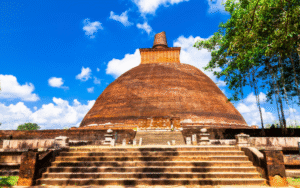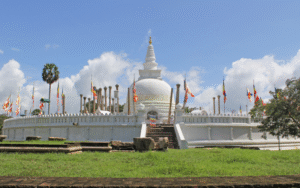Anuradhapura – The Ancient Capital of Sri Lanka
Anuradhapura, one of the greatest and most celebrated cities of ancient Sri Lanka, is a UNESCO World Heritage Site and a sacred destination for Buddhists around the world. Located in the North Central Province, this historic city was the first capital of Sri Lanka (from the 4th century BC to the 11th century AD), serving as the political and religious heart of the island for more than 1,300 years.
A Sacred Heritage
Anuradhapura is considered the cradle of Sri Lanka’s Buddhist civilization. It was here that Buddhism first flourished after the arrival of Arahat Mahinda Thero in the 3rd century BC, bringing the teachings of the Buddha from India. The city became the spiritual center of the country, filled with magnificent temples, monasteries, and colossal stupas that still stand proudly today.
Iconic Attractions in Anuradhapura
Anuradhapura is a treasure trove of historical and religious monuments that draw pilgrims and tourists alike:
-
Sri Maha Bodhi Tree – The oldest historically documented tree in the world, grown from a sapling of the sacred Bodhi tree in India under which the Buddha attained enlightenment. It has been worshipped continuously for over 2,000 years.
-
Ruwanwelisaya Stupa – A massive white dagoba built by King Dutugemunu in the 2nd century BC, considered one of the most revered monuments in Sri Lanka.
-
Jetavanaramaya Stupa – Once the tallest stupa in the ancient world, standing at 122 meters, it symbolizes the architectural brilliance of ancient Sri Lanka.
-
Thuparamaya Dagoba – The very first Buddhist stupa built in Sri Lanka, enshrining the collarbone relic of the Buddha.
-
Isurumuniya Temple – Famous for its rock carvings, including the well-known “Lovers’ statue,” showcasing the artistic skills of the ancient kingdom.
-
Twin Ponds (Kuttam Pokuna) – Ingenious examples of ancient hydraulic engineering, used as bathing pools by Buddhist monks.
A Marvel of Ancient Engineering
Anuradhapura was not only a religious capital but also a marvel of urban planning and irrigation technology. The city was supported by an advanced network of tanks (reservoirs) and canals, including giants like Tissa Wewa and Nuwara Wewa, which sustained agriculture and livelihoods for centuries. These systems demonstrate the remarkable knowledge of water management possessed by the ancient Sinhalese.
Cultural and Spiritual Significance
Even today, Anuradhapura remains a living heritage city, with thousands of pilgrims dressed in white visiting its sacred sites daily. The chanting of prayers, the lighting of oil lamps, and the serene atmosphere make it not just a tourist attraction but also a deeply spiritual experience.
Why Visit Anuradhapura?
For travelers seeking to explore the roots of Sri Lanka’s civilization, Anuradhapura is a must-visit destination. It offers a unique blend of history, archaeology, religion, and culture. Walking among its towering stupas, ancient palaces, and sacred shrines allows visitors to step back in time and witness the grandeur of one of the greatest kingdoms in South Asia.






